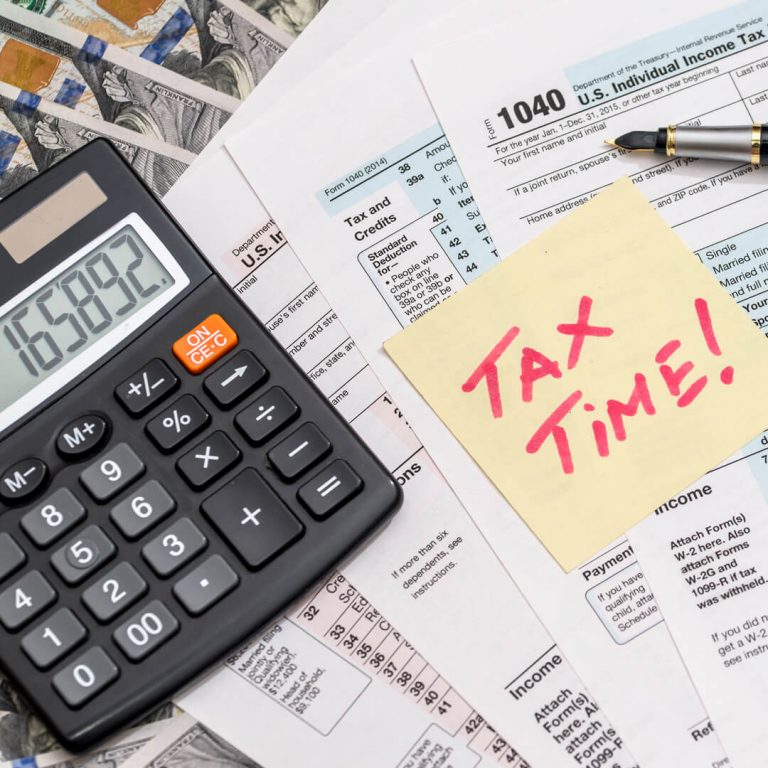There aren’t many annual rituals that people dread more than doing their taxes. Even for those who typically get a refund, there’s still the business of preparing and filing your federal and state returns, which takes time and effort that few of us have to spare. That’s why we’ve put together this month-by-month guide to help reduce your stress and keep you on track this tax season.
January
You can knock out several preparatory tasks in the first few weeks of January, even though the IRS doesn’t typically start accepting returns until later in the month.
- Make a list of everything you’ll need to file your return: Here are some of the most common things to include on that list:
-
- A social security number for you, your spouse and any dependents you plan to claim
- Last year’s federal and state returns
- Documentation of any federal, state or local estimated taxes you paid the previous year
- A W-2 from every employer you worked for last year
- 1099s for earnings generated by interest, dividends and freelance or contract work
- Personal and business receipts
- Gather your receipts: Whether you typically itemize your deductions or not, it’s a good idea to pull together all relevant receipts, such as healthcare bills you paid out-of-pocket, donations given to charities and energy-saving purchases you made. Reviewing your credit card annual summaries and your checking account activity helps locate potentially deductible expenses.
- Create a tax file: It can be paper-based or electronic, but designate a place to store all of your tax documents until you’re ready to prepare your return.
- Note your changes: If you experienced big life changes, such as getting married, going through a divorce, being widowed, having a child or adopting one, this will affect your tax return. The same goes for big financial changes, such as buying or selling a house, refinancing your mortgage, buying and selling stocks or starting, selling or closing a business.
- Decide how you’ll prepare your taxes: If you meet the IRS income limit, which was $73,000 for 2022 returns, you can use the IRS Free File to electronically prepare and file your return for free. Another option is hiring a tax professional, in which case you should make an appointment now. Alternatively, many people today use tax software from companies like H&R Block, TaxAct, TaxSlayer or TurboTax. It’s relatively simple and, in some cases, cheaper than an accountant. But don’t forget that these are businesses who want to make a buck while making filing easier. Therefore, you’ll find that tax software typically gets more expensive as tax day approaches. You’re better off buying it early in January than later in the tax season.
- Watch for tax documents: Even though January 31 is the deadline for companies to send out W2s and 1099s, some send them earlier. Check your mailbox or email inbox throughout the month in order to put these documents in the file you created for this tax season. Also put any letters or documents in it that you receive from the IRS related to this year’s filing.
February
With just over a month and half until Tax Day, keep your momentum going:
- Check your tax documents: The more organized and complete your information is, the faster and easier the tax preparation process will be and the less likely you’ll have costly errors and omissions on your return. So, make sure that you have received a W2 from every company you worked for as an employee last year. If you worked on a contract basis—for example, as a rideshare driver, and earned $600 or more, you should receive a 1099-NEC for this non-employee compensation. Additionally, financial institutions must send you a 1099-INT or 1099-DIV if you earned $10 or more in interest, dividends or capital gains. You may also receive 1099 forms reporting your state and local tax refunds, IRA/pension distributions, Social Security benefits and more. It may be helpful to make a spreadsheet of the documents you’re expecting and check them off upon receipt.
- Request missing or corrected documents: If you are missing any W2s, 1099s or other tax documents or received incorrect ones, notify the appropriate sender immediately.
- Begin your tax return: Once you have all your documents, send them to your tax preparer or start your return via IRS Free File or the tax software of your choice.
- Start saving for your tax payment: If your prepared return indicates that federal or state income tax is due and you don’t have the cash on hand, determine a plan to save up that money between now and Tax Day.
- File and plan for your tax refund: On the other hand, go ahead and file if you’re expecting a tax refund. Filing your taxes as soon as possible reduces the risk of February is also the time to figure out a smart use for your refund, such as building up your emergency fund or paying off some debt.
March
With less than 50 days to go, it’s time for a status check:
- Get caught up: If you haven’t started your tax return, make it a priority now.
- Continue saving for your tax payment: Keep setting aside the money you need to pay Uncle Sam in April.
- Finalize your refund plan: Retirement savings and investments in your home also make wise uses for your tax refund.
April
There are just a few more tasks to complete:
- Maximize tax-free contributions to retirement plans: Such contributions can also help reduce your taxable income. Starting with tax year 2023, the maximum contribution to a 401(k) is $22,500, and to an IRA is $6,500 for people under 50 and up to $7,500 for those 50 and over. Only contributions to a traditional IRA are tax deductible, but you enjoy the tax advantage of Roth IRAs once you turn 59½ and don’t have to pay tax on qualified distributions. You have until the federal tax filing deadline to make last year’s contribution to a qualifying traditional or Roth IRA if you meet the IRS criteria.
- File your taxes by the deadline: Filing your tax return by the annual deadline is important for avoiding interest on your tax liability, potential penalties and even criminal prosecution for tax evasion. The standard federal tax filing deadline is April 15, unless that date falls on a Saturday or Sunday, in which case the IRS delays the deadline until the next business day. State income tax deadlines may vary.
- File an extension if needed:. If you really can’t finish your return by the deadline, you can file an extension, which gives you until mid-October to file. However, the IRS suggests estimating your tax liability and paying that amount with your extension in order to limit potential interest and penalties. Even if you don’t have all the money to pay, file your taxes or an extension anyway and pay what you can. Then apply for a payment plan with the IRS to avoid the harshest penalties.
- Adjust for next year: The smartest tax strategy is to neither owe taxes nor get a large refund at tax time. If your return indicates that you significantly overpaid or underpaid income taxes for last year, make changes to avoid this when you file your return next year. This can include updating your W-4. Additionally, doing things like can reduce your taxable income and therefore your tax liability because the money is taken out through payroll deductions on a pre-tax basis. In some cases with a large tax bill, these tax strategies may not be enough and you may also need to make estimated tax payments throughout the year.
- Evaluate your itemized deduction strategy: Common itemized deductions include charitable contributions, property tax payments and mortgage interest. Although no longer available to employees, the self-employed can still take advantage of the
Once the above tasks are completed, pledge to keep your financial records organized for the coming year by using a to stay on top of important tax deadlines and documents and to set reminders for grabbing a copy of your free annual credit report and filing any property tax exemptions offered in your area that reduce tax bills or provide tax breaks for veterans, the elderly or those who are disabled. (Check with your local property tax office to learn which exemptions may apply to your situation.)
You’ll also want to create a new physical or digital file as your one place for storing this year’s receipts and keeping track of deductible expenses. These strategies will ensure next year’s tax preparation goes even smoother than this years.
Editor’s note: Quorum is not affiliated with any of the companies mentioned in this article and derives no benefit from these businesses for placement in this article.
Before altering your tax strategy, it’s important to sit down and consult with your tax specialist. They have a firm understanding of your wants and needs, as well as the knowledge of tax law required to maximize your wealth potential.






Comments Section
Please note: Comments are not monitored for member servicing inquiries and will not be published. If you have a question or comment about a Quorum product or account, please visit quorumfcu.org to submit a query with our Member Service Team. Thank you.